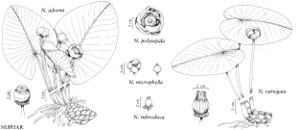Nuphar
in J. Sibthorp & J. E. Smith, Fl. Graec. Prodr. 1: 361. 1809, name conserved.
| Taxon | Illustrator ⠉ | |
|---|---|---|
 | Nuphar advena Nuphar polysepala Nuphar variegata Nuphar rubrodisca Nuphar microphylla | John Myers John Myers John Myers John Myers John Myers |
Rhizomes branched, repent; stolons absent. Leaves floating, submersed, or emersed. Leaf-blade orbiculate to linear, basal lobes divergent to overlapping, margins entire, apex of lobe narrowly obtuse to broadly rounded; primary venation mostly pinnate, basal section of midrib with several parallel veins. Flowers floating or held above surface of water, opening diurnally; perianth hypogynous, not spreading, nearly globose at anthesis; sepals 5-9 (-12), outwardly yellow to green, becoming yellow within, often red-tinged, oblong or obovate to somewhat orbiculate; petals numerous, spirally arranged, inconspicuous, stamenlike; stamens yellow or red-tinged, inserted below ovary, recurved at dehiscence, distal connective appendage absent; ovary longer than petals and stamens; stigmatic disk with margin entire to crenate or dentate, appendages absent. Fruits borne on straight peduncles. Seeds ovoid, to 6 mm; aril absent. x = 17.
Distribution
North temperate, North America, Europe, and Asia
Discussion
Species 10-12, most intergrading and sometimes treated at subspecies rank (8 in the flora).
The taxonomy of the genus is problematic. E. O. Beal (1956) departed dramatically from previous North American treatments in recognizing a single polymorphic species, Nuphar lutea (name of European origin), with several subspecies formerly treated as species. Subsequent research (C. E. DePoe and E. O. Beal 1969; E. O. Beal and R. M. Southall 1977) has supported Beal's treatment for some southeastern subspecies, but most other taxa have not been studied as extensively. Beal's treatment, for the most part, has not been adopted in the Northeast and elsewhere in North America or in Europe. Molecular studies of Nuphar currently in progress (D. J. Padgett, pers. comm.) have clearly shown the North American taxa to be distinct from the Eurasian Nuphar lutea; Beal's nomenclature under that taxon cannot be upheld. Continuing to treat those taxa at subspecific rank would require new combinations under Nuphar sagittifolia (Walter) Pursh, the oldest name that has hitherto been applied only in a geographically restricted sense. Until the molecular studies are completed, creating new names is premature. We therefore return to the previous treatment of the taxa as species.
Prior to conservation in its current sense, the name Nymphaea was frequently used for Nuphar. Although often treated as neuter, Nuphar was originally assigned the feminine gender (W. T. Stearn 1956; H. W. Rickett and F. A. Stafleu 1959).
The name Nymphozanthus Richard has been rejected.
Selected References
None.
Lower Taxa
Key
| 1 | Sepals usually 5–6; fruit deeply constricted below stigmatic disk; stigmatic disk red. | > 2 |
| 1 | Sepals usually 6–12; fruit slightly or not constricted below stigmatic disk; stigmatic disk green, yellow, or occasionally reddened. | > 3 |
| 2 | Anthers 1–3 mm; stigmatic disk with 6–10 deep crenations, stigmatic rays terminating 0–0.2 mm from margin of disk, constriction below disk 1.5–5 mm diam.; leaf sinus 2/3 or more length of midrib. | Nuphar microphylla |
| 2 | Anthers (2–)3–6 mm; stigmatic disk with 8–15 shallow crenations, stigmatic rays terminating 0–1.6 mm from margin of disk, constriction below disk 5–10 mm diam.; leaf sinus ca. 1/2 length of midrib. | Nuphar rubrodisca |
| 3 | Leaf blade more than 2 times as long as wide; sinus less than 1/3 length of midrib. | > 4 |
| 3 | Leaf blade to 2 times as long as wide; sinus 1/3 or more length of midrib. | > 5 |
| 4 | Leaf blade lanceolate to ovate, ca. 2.5 times as long as wide; stigmatic rays ± elliptic. | Nuphar ulvacea |
| 4 | Leaf blade linear to lanceolate, 3–5 times as long as wide; stigmatic rays linear. | Nuphar sagittifolia |
| 5 | Leaf petiole adaxially flattened and winged along margins; fruit usually purplish; sepals red or maroon at base adaxially. | Nuphar variegata |
| 5 | Leaf petiole terete or slightly flattened adaxially; fruit mostly greenish or yellowish, rarely reddened; sepals yellow or red at base adaxially. | > 6 |
| 6 | Sepals usually (6–)9(–12); stigmatic rays terminating within 1(–1.5) mm from margin of disk. | Nuphar polysepala |
| 6 | Sepals usually 6; stigmatic rays terminating 1–3 mm from margin of disk. | > 7 |
| 7 | Leaves mostly floating; leaf blade orbiculate or nearly so, abaxially densely pubescent. | Nuphar orbiculata |
| 7 | Leaves mostly emersed; leaf blade ovate to nearly orbiculate, abaxially glabrous to sparsely pubescent. | Nuphar advena |